You're Born to be a Black Belt
Stances
 |
- Heels are together.
- The angle between the feet is 45 degrees.
- The body weight is distributed evenly between each
leg.
- The legs are straight.
|
Back to Top
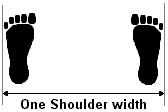 |
- Each foot points forwards.
- The width ( measured between the footswords )
is one shoulder width.
- The legs are straight.
- The body weight is distributed evenly between
each leg.
|
Back to Top
 |
- The feet are together.
- Each foot points forwards.
- The legs are straight.
- The body weight is distributed evenly between each
leg.
|
Back to Top
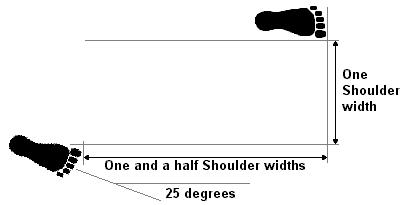 |
- One foot is moved to the rear a distance of one and a half
shoulder widths.
- The width ( measured between the centre of the insteps ) is
one shoulder width.
- The front leg is bent so that the kneecap is vertically
above the heel.
The back leg is straight and extended fully.
- The front foot points forward and the rear foot is turned
outwards at an angle
of 25 degrees.
- The body weight is distributed evenly between each
leg.
|
Back to Top
 |
- One foot is moved to the rear a distance of one and a half shoulder widths from the footsword of the rear foot to the toes of the front foot, forming
almost a right angle.
- Both feet should be turned inwards about 15
degrees.
- The rear leg should be bent so that the kneecap is above the
toes and the front leg should be bent proportionally.
- The hip should be aligned with the inner knee joint.
- The ratio of body weight should be 70% on the rear leg and
30% on the front leg.
|
Back to Top
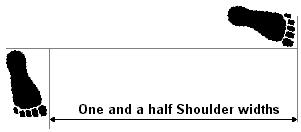 |
|
This stance is similar to L-Stance with the
following exceptions:
- The body weight is distributed evenly.
- The length of the stance is one and a half shoulder widths
between big toes.
- When the right foot is in front it is called a right fixed
stance and vice-versa
|
Back to Top
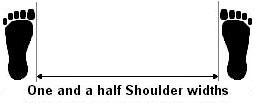 |
- One leg is moved to the side so that the distance between big
toes is
one and a half shoulder widths.
- Both feet should pointing forwards.
- Bend the knees so the knee caps are above the ball of the
foot.
- Body weight is evenly distributed on each foot.
- Push the chest and abdomen out and pull the hips back.
- Tense the inner thigh as though squeezing the floor
inwards.
|
Back to Top
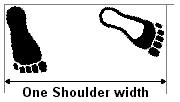 |
- One foot is moved to the front a distance
of one shoulder width between small toes.
- Bend the rear leg until the knee is above the toes.
- Bend the front leg touching the ground slightly with
the ball of the foot.
- The front foot should point inward 25 degrees.
- The rear foot should point inward 15 degrees.
- Most of the body weight is on the rear
foot.
|
Back to Top
 |
- One foot is moved to the side a distance of
one shoulder width (measured between big toes).
- The ratio of body weight should be
60% on rear leg and 40% on the front leg.
- Both feet should be pointed inwards 15 degrees.
- The legs should be kept straight
- When the right foot is in the rear it is
called a right vertical stance and
vice-versa.
|
Back to Top
 |
- One foot is crossed over or behind the other, touching the
ground slightly with the ball of the foot.
- The body weight is on the stationary foot.
- Both legs are bent.
- One foot always crosses in front of the other except when
jumping.
- When the weight is on the right foot, the stance is called
a right X-stance and vice-versa.
|
Back to Top |
Links to ITF other Websites









